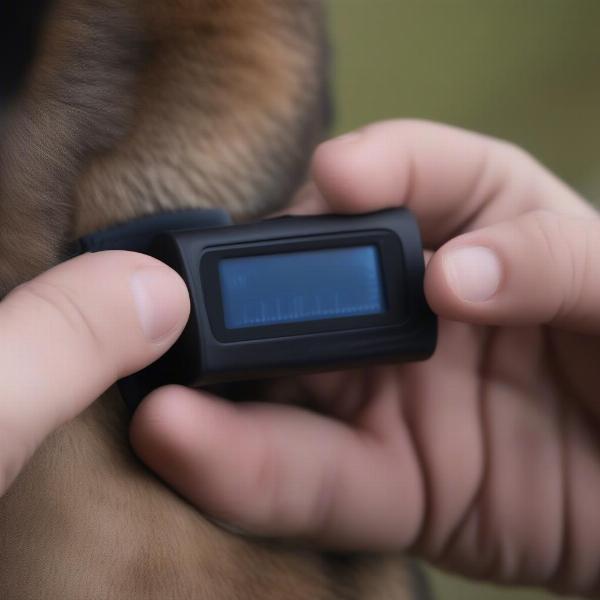Bark collars are often a topic of discussion among dog owners, especially those dealing with excessive barking. Whether you’re a seasoned dog owner or just starting out, understanding how bark collars work, their different types, and the best practices for using them is crucial for your dog’s well-being and your peace of mind. This guide provides a complete overview of bark collars for dogs, helping you navigate the choices and make informed decisions.
Types of Bark Collars
There are various types of bark collars available, each employing different methods to deter barking. Choosing the right one depends on your dog’s temperament, size, and the severity of the barking issue.
Citronella Bark Collars
These collars release a burst of citronella spray when the dog barks. The scent is unpleasant for most dogs, interrupting the barking behavior. This is generally considered a humane and effective method, especially for sensitive dogs.
Ultrasonic Bark Collars
Ultrasonic collars emit a high-pitched sound that humans can’t hear but is disruptive to dogs. The sound is activated when the dog barks, startling them and interrupting the barking.
Vibration Bark Collars
Vibration collars deliver a gentle vibration when the dog barks. This provides a non-painful but noticeable sensation that can deter barking. This is a good option for dogs that are sensitive to sounds or smells.
Shock Bark Collars (Static Stimulation Collars)
These collars deliver a mild electric shock when the dog barks. While often effective, shock collars are controversial and should be used with caution and as a last resort. It’s important to choose a collar with adjustable intensity levels and to start with the lowest setting.
Choosing the Right Bark Collar
Choosing the right bark collar requires careful consideration of your dog’s individual needs. Factors such as size, breed, and sensitivity should be taken into account.
Size and Breed Considerations
Ensure the collar fits comfortably and isn’t too tight or too loose. Some collars are specifically designed for small or large breeds.
Sensitivity Levels
Dogs have varying sensitivities to stimuli. Start with the lowest setting and gradually increase it only if necessary. Observe your dog’s reaction carefully.
How to Use a Bark Collar Effectively
Proper usage is key to the effectiveness of any bark collar. Here are some guidelines to follow:
- Consistency: Use the collar consistently every time your dog barks excessively.
- Positive Reinforcement: Combine the collar with positive reinforcement training methods to address the underlying cause of the barking.
- Supervision: Supervise your dog while they’re wearing the collar, especially initially.
- Veterinarian Consultation: Consult your veterinarian before using a bark collar, especially if your dog has any underlying health conditions.
Potential Side Effects and Considerations
While bark collars can be helpful, it’s important to be aware of potential side effects:
- Skin Irritation: Some dogs may experience skin irritation from the collar material.
- Increased Anxiety: In some cases, the collar may exacerbate anxiety or fear.
- Behavioral Changes: Observe your dog for any changes in behavior.
 Adjusting Ultrasonic Bark Collar
Adjusting Ultrasonic Bark Collar
Conclusion
Bark collars can be a useful tool in managing excessive barking when used correctly and responsibly. Choosing the right type of collar and following proper usage guidelines is essential for your dog’s well-being. Remember to address the underlying cause of the barking through training and behavioral modification.
FAQ
- Are bark collars humane? Most bark collars are designed to be humane, particularly citronella, vibration, and ultrasonic collars. Shock collars should be used with caution and as a last resort.
- How long should my dog wear a bark collar? It’s best to limit the time your dog wears the collar and use it only when necessary.
- Can bark collars be used on puppies? Consult your veterinarian before using a bark collar on a puppy.
- What if the bark collar doesn’t work? If the bark collar isn’t effective, consult a professional dog trainer or behaviorist.
- Are there any alternatives to bark collars? Yes, alternatives include training, behavior modification, and addressing any underlying anxiety or environmental triggers.
best bark collar for stubborn dogs
shock barking collars for dogs
bark collar for small dogs under 5 lbs
dog bark collars for large dogs
ILM Dog is your trusted resource for dog care and training information. We offer expert advice on dog breeds, health, training, nutrition, grooming, and more. Whether you’re a new dog owner or have years of experience, ILM Dog can help you provide the best possible care for your canine companion. Contact us at [email protected] or +44 20-3965-8624 for personalized guidance and support.